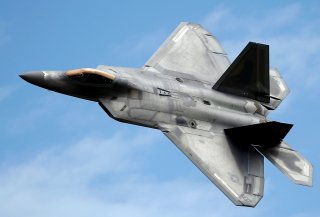The F-22 Is Becoming A Force Multiplier For America's Non-Stealth Fighters
2020 could be the year the Raptor finally fulfills its promise as the world’s best fighter.
Key Point: The Raptor with its stealth and powerful sensors could help direct other forces in combat, provided it voicelessly can communicate.
The Air Force and Lockheed plan to begin installing on the roughly 180 F-22s the Link-16 datalink, which allows U.S. and allied forces to swap location and targeting data via voiceless radio message.
Link-16 is standard on U.S. and allied planes, ships and air-defense systems, but the F-22 at present doesn’t include the system. That’s because the F-22 with its stealth features could give away its location by broadcasting Link-16 messages.
Raptor pilots wordlessly can communicate with each other by way of the F-22’s unique, highly-secure datalink. But to communicate with, say, the pilot of a nearby F-16, a Raptor pilot must open a radio channel and just … talk.
It’s a big flaw in the F-22’s way of operating. The Raptor with its stealth and powerful sensors could help direct other forces in combat, provided it voicelessly can communicate. The Air Force at present is willing somewhat to compromise the F-22’s stealth in order to make it more of a collaborative system.
“Link-16 transmit capability could enable the stealthy F-22 to operate in concert with coalition air operations as a quarterback, enabling the plane to share its ‘God’s eye view’ of the battlespace with other aircraft,” Air Force Magazine reporter Shaun Waterman paraphrased Orlando Sanchez, Jr., Lockheed’s vice president of F-22 programs, as saying.
“The F-22 is the quarterback … that’s what it feels like, you have all this information and you can call plays,” Sanchez told Waterman.
The Air Force long has wanted to solve the Raptor’s data-link problem, but contracting procedures got in the way. In 2017 the service finally found a way to accelerate the update, Waterman explained.
“Two years ago, faced with mounting delays in F-22 modernization efforts that threatened the fighter’s dominance over its competitors, the Air Force decided to reform the way it rolls out updates to the Raptor,” Waterman wrote.
“Instead of a conventional approach, in which requirements are documented in detail and the update is not delivered until every element is complete, USAF wanted to introduce new capabilities on a rolling basis using an approach known as ‘agile’ development.”
The Air Force four years ago restructured ongoing F-22 modernization efforts into “an agile capability delivery pipeline,” Waterman explained. With many smaller updates instead of fewer, bigger ones, modernization that once took a decade or longer now could begin happening in just a few years.
For the Air Force, adding Link-16 to the F-22 became a top priority, according to Waterman. “In February 2018, the F-22 program office used new acquisition authorities under section 804 of the Fiscal 2016 National Defense Authorization Act to issue a task order to Lockheed Martin—the Raptor Agile Capability Release, or RACR, contract.”
“In fiscal 2019, RACR was funded for $140 million, out of the office’s $563 million research and development budget—part of the $2.7 billion total direct cost of modernization and sustainment for the F-22 that year, according to Rusnock.”
The 2019 appropriation finally allowed the Air Force and Lockheed to begin installing initial Link-16 capability on the Raptor fleet starting in 2020.
With Link-16, the new approach means F-22 pilots will be able to get some capability while waiting for more, rather than all or nothing. Link-16 capabilities consist of hundreds of potential data messages accompanying location information, from “Here I am,” to “Here’s a bad guy.”
Users will get to decide which are the most important messages, then look to incorporate them in an early release—the first minimum viable product.
Assuming nothing goes wrong and Lockheed indeed succeeds in adding Link-16 to the F-22 force, 2020 could be the year the Raptor finally fulfills its promise as the world’s best fighter, and a warplane that helps the other forces around it perform even better.
David Axe serves as Defense Editor of the National Interest. He is the author of the graphic novels War Fix, War Is Boring and Machete Squad. This first appeared in 2019 and is being reposted due to reader interest.
Image: Reuters

